|
|
 |
Canadian Historic Sites: Occasional Papers in Archaeology and History No. 16
The Western European Coarse Earthenwares from the Wreck of the Machault
by K. J. Barton
The Coarse Earthenwares
The bulk of the coarse earthenware ceramics recovered from the
Machault comprises three types: Type 1, green-glazed white-fabric ware
(Figs. 1-9); Type 2, slip-decorated red-fabric ware (Figs.
10-16), and Type 3, undecorated, unglazed and partly glazed
red-fabric ware (Figs. 17-21). The remainder are miscellaneous
decorated and undecorated coarse earthenwares (Figs. 22-27).
Type 1: Green-Glazed White-Fabric Ware
The green-glazed white-fabric vessels are jugs, flagons, bowls,
skillets, tripod cooking pots with lids, cream pans, storage jars and
plates (Figs. 1-9).
The fabric is cream buff or pale pink in colour with a smooth chalky
texture. No deliberately introduced inclusions appear in the fabric, but
very small ochrous pebbles occasionally occur.
The vessels were poorly thrown and were cut from a stilled wheel with
wire. The handles were press-moulded in a box. Each handle was fastened
to the top of the rim and basally fastened to the outside of the body
by pressing the handle out and smoothing it down.
In all cases, the lead glaze is stained bright apple green with
copper oxide. Minor impurities, possibly of iron, cause occasional
staining in the glaze. Subsequent to manufacture, the glaze on many of the
vessels was attacked and blackened (see Appendix A). The glaze is
often markedly crackled. The vessels were dip glazed and
intentionally glazed internally. The majority were not glazed on the
base.
The majority of the vessels were fired upside down, some on the side,
and were stacked very closely together during firing, resulting in many
"stick" marks.
The above descriptions fit all vessels in Type 1 unless otherwise
stated.
1. Jugs
The jugs (Figs. 1, 2) have globular bodies and pulled spouts. The
small jug illustrated in Figure 1e and Figure 2a is the
only example of its kind which suggests that it may be from the crew's
supplies and not cargo. The jugs can be divided into four groups on the
basis of size. There was a sufficient number of jugs to make comparative
measurements: 2 examples of the largest size (Figs. 1a,
2d), 5 examples of the second-largest size (Figs. 1b,
2c), 15 examples of the third-largest size (Figs. 1c, d,
2b), and 1 example of the smallest size (Figs. 1e,
2a).
|
| Rim |
Base | Height |
|
| Largest size |
|
| Maximum | 11.8 | 12.9 | 32.5 |
| Minimum | 11.0 | 14.1 | 31.7 |
| Mean | 11.4 | 13.5 | 32.1 |
|
| Second-largest size |
|
| Maximum | 9.8 | 9.6 | 22.5 |
| Minimum | 9.1 | 9.4 | 21.5 |
| Mean | 9.6 | 9.4 | 22.0 |
|
| Third-largest size |
|
| Maximum | 9.3 | 8.2 | 17.5 |
| Minimum | 8.0 | 6.5 | 15.3 |
| Mean | 8.6 | 7.3 | 16.3 |
|
| Smallest size |
|
| Mean | 8.3 | 6.5 | 11.6 |
|
The capacities of complete jugs in each of the four size groups were
measured. Two measurements were taken from each jug: Maximum A, capacity
when the jug was filled to the lip, and Maximum B, capacity when the jug
was filled to the neck. In use, a jug would probably have been filled to
a level between the bottom of the neck and the lip. The following
measurements are in millilitres.
|
| Maximum A | Maximum B |
|
| Largest size |
|
|
| 5,200 | 4,765 |
| 5,100 | 4,375 |
|
| Second-largest size |
|
| 1,790 | 1,500 |
| 1,750 | 1,600 |
| 1,750 | 1,400 |
| 1,720 | 1,345 |
|
| Third-largest size |
|
| 925 | 700 |
| 860 | 690 |
| 755 | 565 |
| 735 | 575 |
| 700 | 540 |
| 680 | 555 |
|
| Smallest size |
|
|
| 325 | 200 |
|
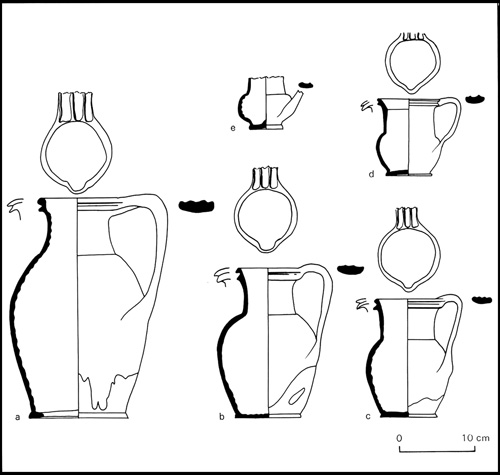
1 Green-glazed white-fabric ware (Type 1) jugs: a, largest size;
b, second-largest size; c, third largest size; d,
third-largest size, and e, smallest size.
(Drawing by author.)
|

2 Green-glazed white-fabric ware (Type 1) jugs: a, smallest size;
b, third-largest site; c, second-largest size, and
d, largest size.
(Photo by J. Jolin.)
|
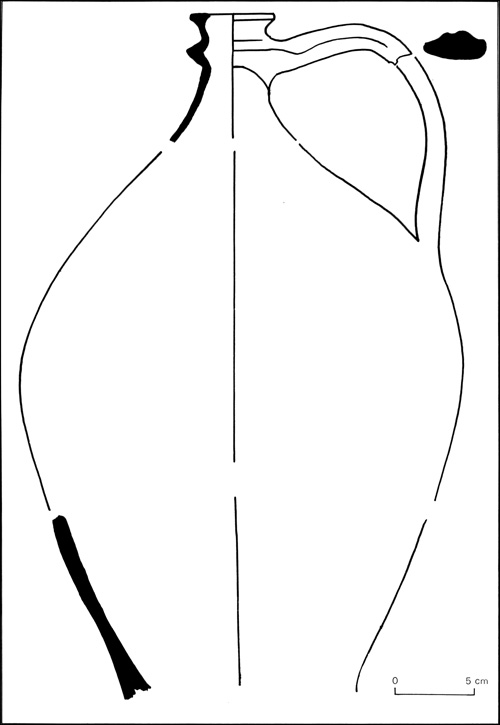
3 Green-glazed white-fabric ware (Type 1) flagon.
(Drawing by author.)
|
2. Flagons
A fragment of the spout and handle of one vessel and several
fragments of the lower portion of other similar vessels were recovered
(Figs. 3, 6a). The strap handle is held to the neck under the rim
on a wide flange. (The writer has such a vessel, purchased in Saintes,
Charente-Maritime, in his collection.) Comparative material occurs in
the Fortress of Louisbourg collection.
3. Barbers' Bowls
Fragments of the rims and upper portion of several examples of these
wide-flanged bowls, with two slightly different profiles as illustrated
(Fig. 4a, b), were recovered. After throwing, a large
semi-circular piece was cut from each bowl rim with a wire. The cut
edges were not trimmed.
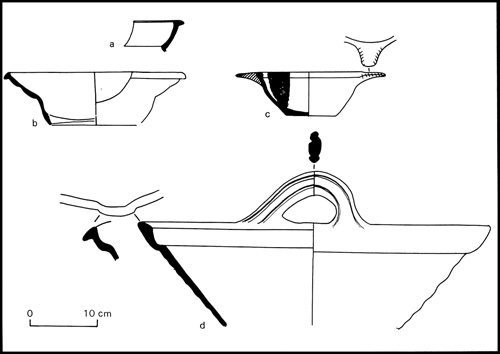
4 Green-glazed white-fabric ware (Type 1) vessels; a, barber's
bowl; b, barber's bowl; c, porringer, and d, cream
pan.
(Drawing by author.)
|
4. Porringers
Fragments of several small-rimmed bowls and handles of similar form
to the one illustrated (Figs. 4c, 6d) were recovered. The
example illustrated is a composite from several fragments. The handle
illustrated is lightly slashed along its edges whereas the others that
were examined were not treated in this way. The exteriors are clear
yellow-glazed. They are decorated in probably four places on the inside
of the bowl with a sprinkling of iron powder put on the wet glaze.
5. Cream Pans
The vessel illustrated in Figure 4d, a cream pan with two
loop-handles and a square pouring spout, is a composite from several
fragments. Each handle is a moulded strap handle applied on its side to
the upper rim of the vessel (Fig. 6b). Some handles are less well
set than others, the holes being too small to grip. These vessels were
mainly fired upside down, but some have been fired rim uppermost. The
rim diameter measurements are all 52 cm. No base fragments were
recognized. Cream pans were also recovered at Louisbourg.
6. Skillets
Twenty-seven fragments of shallow bowls with slight pouring lips are
associated with strap handles joined to the same rim shapes as those on
the bowls. As these rim shapes only occur on such shallow bowls, it is
construed that these two forms belong together to form a shallow skillet
(Figs. 5a, 6c).
Each handle was pierced so the vessel could be suspended when not in
use. The moulded handles widen where they are fastened to the rim of the
bowl and have a cut chamfer at the far end. All the skillets appear to
have been fired rim uppermost. Rim diameters range from 14 cm. to
16 cm.
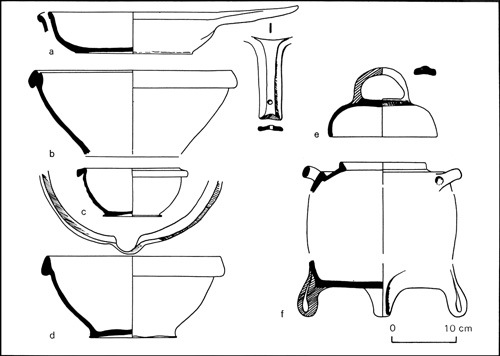
5 Green-glazed white-fabric ware (Type 1) vessels; a, skillet;
b, large lipped bowl with rim grooved on top; c, small
bowl; d, large lipped bowl with egg-shaped rim section; e,
lid of f, and f, tripod everted-rim cooking pot.
(Drawing by author.)
|
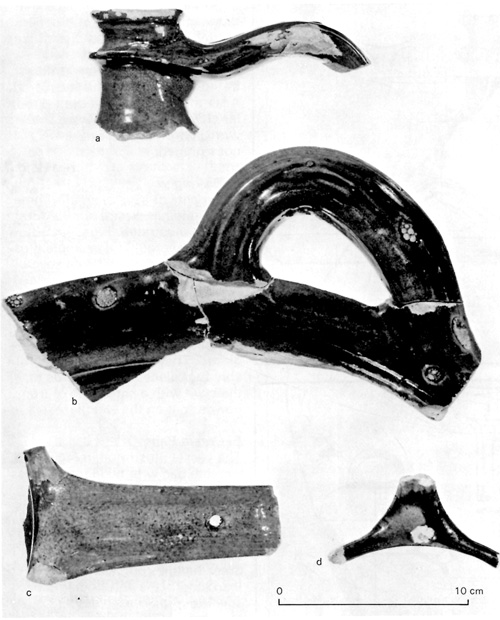
6 Green-glazed white-fabric ware (Type 1) sherds; a, flagon neck
and portion of handle; b, cream pan handle and rim portion;
c, skillet handle, and d, porringer handle.
(Photo by J. Jolin.)
|
7. Large Lipped Bowls
The large lipped bowls are of two kinds, the variation being only in
the rim shape: a number of the rims are grooved on the top (Fig.
5b), but the most common form is the egg-shaped rim section
(Figs. 5d, 7), fired rim uppermost. Diameters for both variants,
20 examples, are:
|
| Rim |
Base | Height |
|
| Maximum | 34.0 | 17.0 | 16.0 |
| Minimum | 28.5 | 14.0 | 13.0 |
| Mean | 31.5 | 15.5 | 14.5 |
|
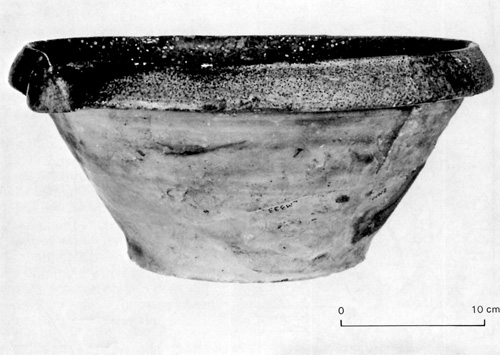
7 Green-glazed white-fabric ware (Type 1) large lipped bowl with
egg-shaped rim section.
(Photo by J. Jolin.)
|
8. Small Bowls
Small well-made vessels with square-section rims were recovered.
There are minor variations of the rims, but they are principally the
same as the example illustrated (Figs. 5 c, 8). Most of these
bowls were fired on their sides; the rest were fired rim uppermost.
Diameters of 50 examples are:
|
| Rim |
Base | Height |
|
| Maximum | 22.0 | 10.0 | 7.5 |
| Minimum | 16.0 | 8.5 | 6.5 |
| Mean | 18.0 | 9.2 | 6.8 |
|
Comparative material was recovered at the Fortress of Louisbourg.

8 Green-glazed white-fabric ware (Type 1) small bowl.
(Photo by G. Lupien.)
|
10. Tripod Everted-Rim Cooking Pots and 9. Associated Lids
The lid illustrated (Fig. 5e) was reconstructed from fragments
as were the rim, base, handles and feet of the cooking pot (Fig.
5f). Both lid and pot are paralleled by complete examples in the
collections at the Fortress of Louisbourg.
The lids were thrown as small cup-shaped bowls, then inverted and a
grooved strap handle applied over the top.
The cooking pots have sharply everted rims on angular shoulders
providing seating to take lids of the form illustrated. Although a pot
could not be reconstructed, the sherds indicated that the body is
drum-shaped. The pots have three feet comprised of pulled lengths of
clay pressed on and folded back. The handles are set horizontally in a
form similar to those on horizontal-handled large storage jars,
see Figure 9a. The way in which the handles are fastened
to the vessel is confirmed by a similar vessel at the Fortress of
Louisbourg.
The vessels were fired on their sides.
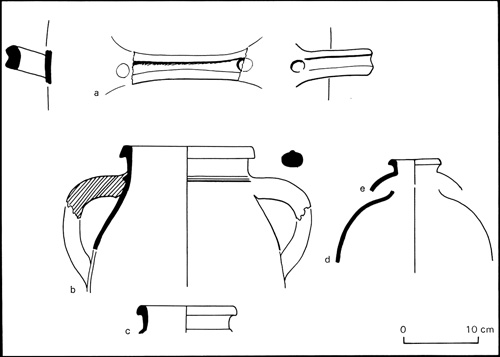
9 Green-glazed white-fabric ware (Type 1) vessels; a, horizontal
handle of a storage jar; b, vertical-handled large storage jar;
c, neck and rim of smaller vertical-handled storage jar;
d, small storage jar, and e, rim, neck and shoulder of
small storage jar.
(Drawing by author.)
|
11. Storage Jars
A. Vertical-Handled Large Storage Jars
Figure 9b is a conjectural drawing of a vertical-handled large
storage jar based on five fragments. The handles are of solid rod
section with a marked ridge on the front and are opposed and set
vertically. The vessels are glazed only on the inside.
Figure 9c illustrates a rim of similar but smaller form of
which two examples exist. The two smaller rims are glazed both inside
and out.
B. Small Storage Jars
One rim fragment (Fig. 9e) and the part of the side of another
vessel (Fig. 9d), glazed on the outside only, were recovered.
They are finely thrown. There is no evidence of any fittings.
C. Horizontal-Handled Large Storage Jars
A large handle of the horizontal type (Fig. 9a) was applied at
a slight angle to each vessel. The handle, box-moulded and fixed with
two deep indentations, was probably from a cylindrical vessel of "bread
crock" type.
12. Plates
Fragments of four plates were recovered, but they were too
insignificant to draw. The inner rim flange averages 18 cm.
13. Base Fragment
One base fragment, possibly from a very thick vessel with
inward-sloping walls, was recovered. It may have been from an alembic (a
vessel used in distillation).
Type 2: Slip-Decorated Red-Fabric Ware
The slip-decorated red-fabric vessels are bowls, dishes and plates
(Figs. 10-16).
The decorated vessels had stood in crates or barrels packed in
vegetable matter and had been burned during the destruction of the
Machault. The burning had the effect of almost completely
destroying all evidence of pattern and colour range as the vessels were
totally blackened on the glazed areas. The decoration was only indicated
by raised lines where the slip was of sufficient height to be seen or
felt.
Similar ware from the Fortress of Louisbourg shows that not only the
burning was responsible for the poor condition of these vessels. The
very poor quality of this ware caused the glaze to flake and fail even
when newly delivered.
The fabric is slightly sandy and its standard colour is brick red.
Large irregular quartz crystals occur naturally but infrequently in the
fabric; these have a greater frequency of distribution in the larger
vessels than in the smaller ones. Flecks of mica are common throughout
the range of vessels.
The throwing of all the vessels is of a high order for earthenwares.
The vessels were cut from a stilled wheel with wire. White clay slip
covers the inside of the vessels, slightly lapping over the edges, a
feature common to all the vessels. Decoration is trailed slip, probably
confined to only two colours — green and brown — on the white
ground. The central design common to all the small vessels is a whorl.
Other than those motifs illustrated (Figs. 10a, b, 11a-f)
there is some evidence for birds and other unidentifiable symbols.
The insides of the vessels are covered with a clear lead glaze, the
colour of which (where it can be seen) appears to be pale green, often
of a slightly creamy nature. The glaze is washed on and does not go
beyond the rim or, in many cases, completely cover the slip.
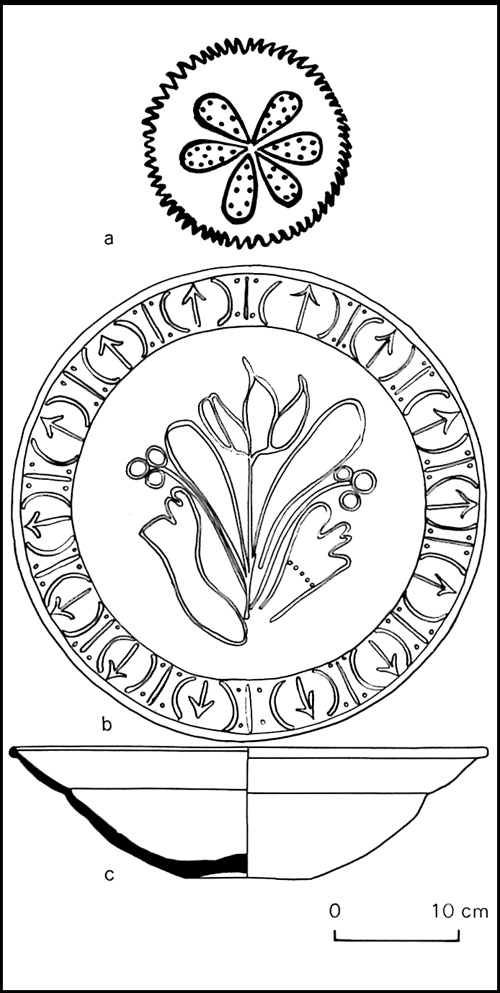
10 Slip-decorated red-fabric ware (Type 2); a, decoration on a
base fragment of a flanged bowl; b, decoration on a flanged bowl,
and c, flanged bowl.
(Drawing by author.)
|
1. Flanged Bowls, Dishes and Plates
With the minor exception of the flanged rim and the motif, these
vessels are all variations of the same form. They are thrown to the same
profile and have the same bead rim, the same foot dimple and the same
sharply defined angles. They should therefore be considered as of one
family, all probably made by the same hand.
A. Flanged Bowls
The decorative motifs on the flanged bowl illustrated in Figure 10c,
band the accompanying base fragment (Fig. 10a) are different from those
of other flanged bowls (although less so in the case of the base
fragment). The tulip motif (Fig. 10b) is drawn from what can be seen in
relief as the bowl is completely blackened.
Although the fabric of this piece has not been examined
miscroscopically, it is included here on the grounds of form and the
fact that it has been burned. The use of a tulip as decoration is,
however, a puzzle if this piece is southwestern French although another
tulip occurs in the Fortress of Louisbourg collection and it is known on
vessels in the northwest and from Beauvais (Oise) in particular where it
is given a general date range of the 17th and 18th centuries (Musée
National de Céramique de Sèvres 1973: 32, Pl. 320).
B. Flanged Dishes
The second-largest size and largest size flanged dishes (Fig. 11i,
j) are decorated with whorls, zig-zags, "circles of dots" (Fig.
11b-e) and "wheat ears" (Fig. 11a). The most common design
used, illustrated in Figure 11c, could be seen on 25 vessels. The
designs illustrated in Figure 1b and d occurred on three
vessels, and each of those illustrated in Figure 11a and e
only on one. No designs were seen on the smallest flanged dishes
examined (Fig. 11h), but many of these dishes were burned into
stacks and a definitive examination was not possible. Dish dimensions
are:
|
| Height | Width |
|
| Largest size flanged dishes |
|
| Maximum | 12.0 | 38.0 |
| Minimum | 9.7 | 31.0 |
| Mean | 10.0 | 34.5 |
|
| Second-largest size flanged dishes |
|
| Maximum | 10.0 | 30.5 |
| Minimum | 7.0 | 25.5 |
| Mean | 8.0 | 28.0 |
|
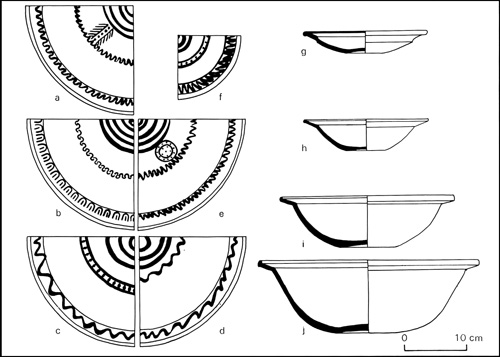
11 Slip-decorated red-fabric ware (Type 2) vessels and associated
decorative motifs; a to e, motifs on flanged dishes; f,
motif on flanged plate; g, flanged plate; h, i and j,
hanged dishes.
(Drawing by author.)
|
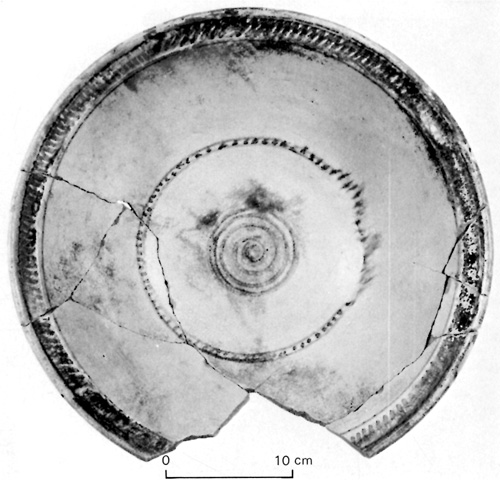
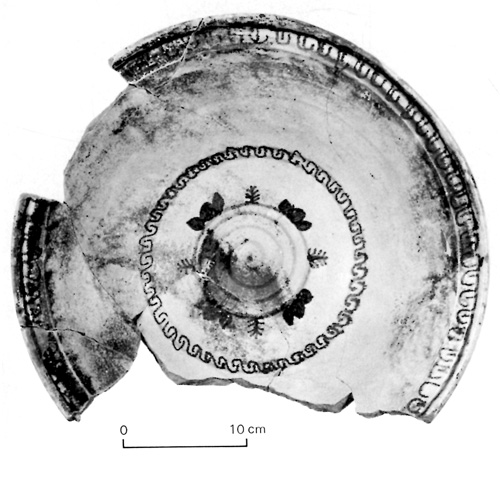
12, 13 Slip-decorated red-fabric ware (Type 2) flanged dish, refired.
(Photos by J. Jolin.)
|
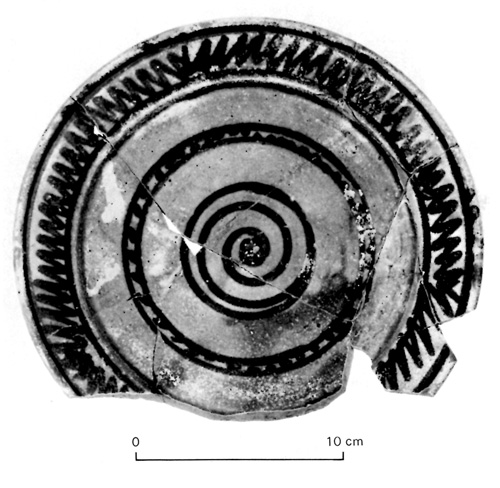
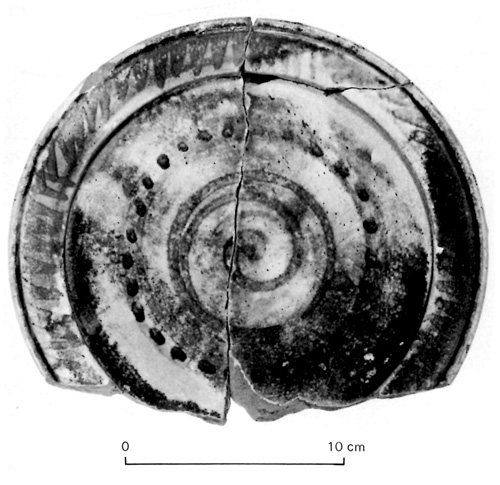
14, 15 Slip-decorated red-fabric ware (Type 2) flanged plate, refired.
(Photos by J. Jolin.)
|
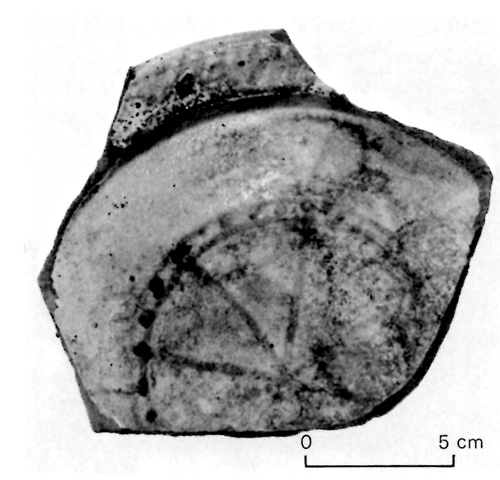
16 Slip-decorated red-fabric ware (Type 2) flanged plate, refired.
(Photo by J. Jolin.)
|
C. Flanged Plates
The flanged plates (Fig. 11g) are all decorated. The
decoration on them (Fig. 11f) is a variant of the design
illustrated in Figure 11c. Plate dimensions are:
|
| Height | Width |
|
| Maximum | 4.8 | 22.0 |
| Minimum | 3.5 | 20.5 |
| Mean | 4.0 | 21.0 |
|
Type 3: Undecorated, Unglazed and Partly Glazed Red-Fabric
Ware
The undecorated, unglazed and partly glazed red-fabric ware is
comprised of cooking pots and storage jars (Figs. 17-21).
The fabric is hard, slightly sandy and brick red in colour, sometimes
firing to a deep buff colour. It contains occasional small quartz
crystals and pieces of mica. The appearance and feel of this fabric is
identical to that of the Type 2 materials.
1. Double-Handled Round-Bottomed Cooking Pots
The double-handled round-bottomed cooking pots (Figs. 17, 18) were
thrown in the same way as the slip-ware. The bases are slightly
flattened and not completely dished. The handles, of rod section, are
fastened to the top of the rims. The basal fastening is pressed onto the
pot and smoothed out. They are glazed only around the inside of the rim
although some pots exhibit traces of glaze on the inside of the base. No
slip; no decoration.
During firing the pots were stacked one on top of another, base on
rim which is indicated by a colour change and the presence of
volatilized glaze from the pot beneath on the outside of the base of the
pot stacked above it.
Two sizes of this form were examined: small (Fig. 17a) and
large (Fig. 17b). Examples of the latter were very fragmentary.
Only one complete example occurred and that was of the small size (Fig.
18). Diameters of rim sizes were the only guide to vessel size:
|
| Small | Large |
|
| Maximum | 25.0 | Maximum | 18.0 |
| Minimum | 20.0 | Minimum | 15.0 |
| Mean | 23.0 | Mean | 16.0 |
|
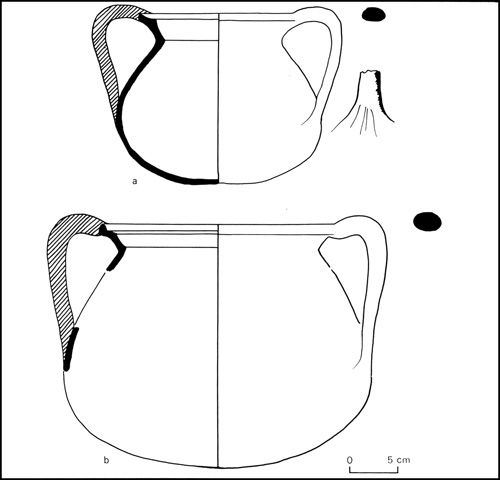
17 Undecorated, partly glazed red-fabric ware (Type 3) double-handled
round-bottomed cooking pots; a, small, and b, large.
(Drawing by author.)
|
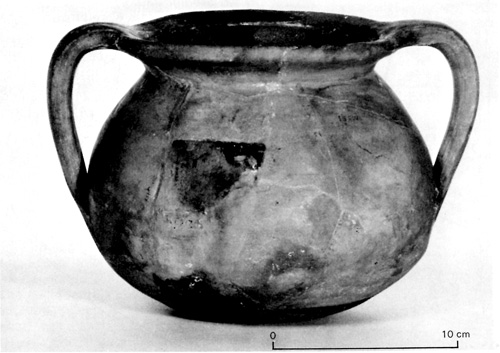
18 Undecorated, partly glazed red-fabric ware (Type 3) small
double-handled round-bottomed cooking pot.
(Photo by J. Jolin.)
|
2. Storage Jars
The storage jars were thrown in one piece and had cut footrings and
bases. No glaze; no decoration. They were fired very hard.
The nearly complete storage jar illustrated (Figs. 19a, 21) is
matched by several fragments of which four rims are of similar form and
size. Only one rim form of the kind illustrated in Figure 19b
occurs. There are three examples of the inscription illustrated in
Figure 20a and one example of the inscription illustrated in
Figure 20b. Comparative material was found at the Fortress of
Louisbourg.
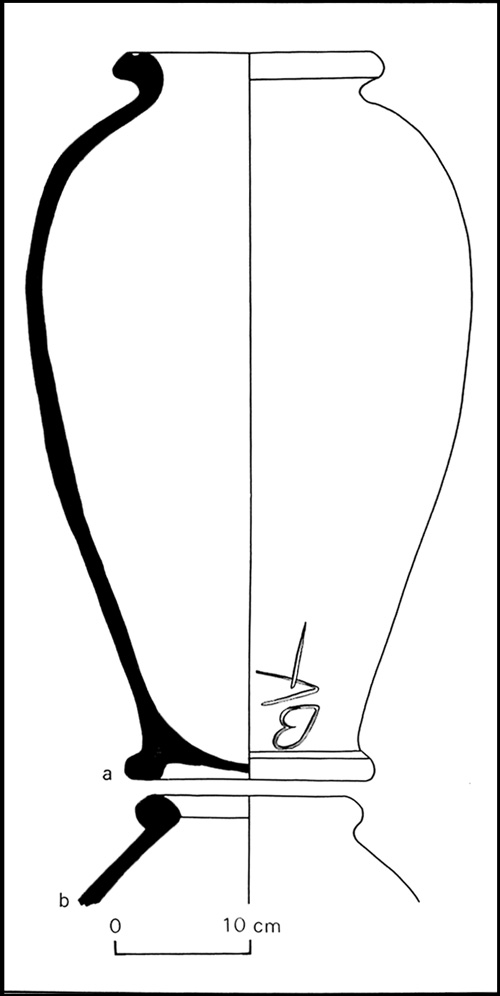
19 Undecorated, unglazed red-fabric (Type 3) storage jars; a,
storage jar, and b, storage jar rim and neck.
(Drawing by
author.)
|
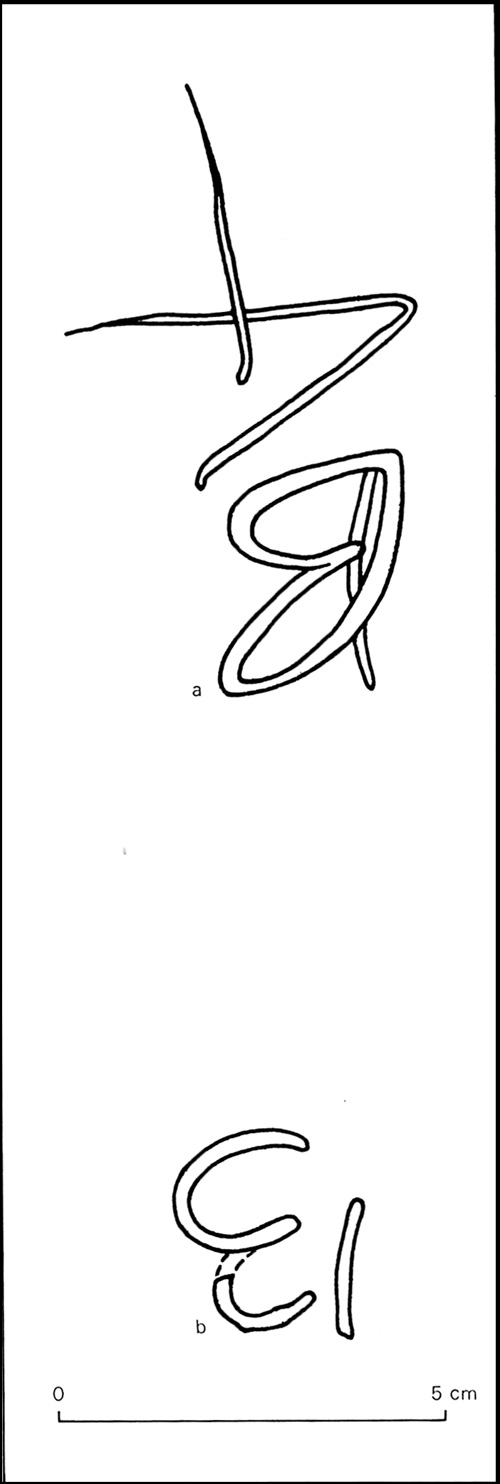
20 Inscriptions on undecorated, unglazed red-fabric ware (Type 3)
storage jars.
(Drawing by G. Kappler.)
|
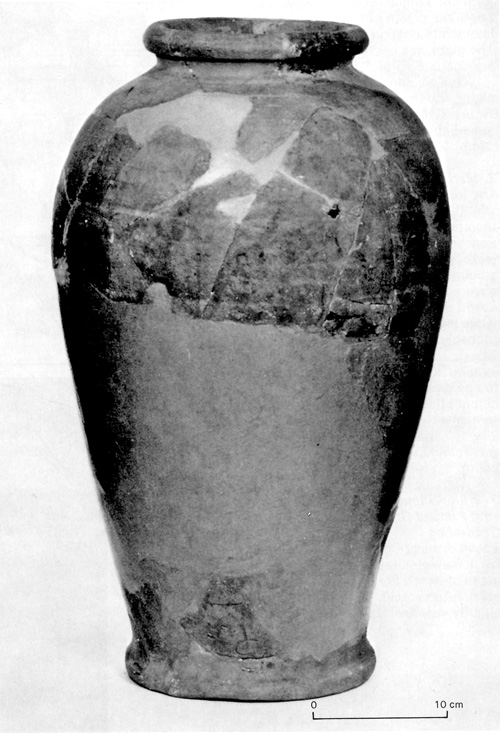
21 Undecorated, unglazed red-fabric ware (Type 3) reconstructed storage
jar.
(Photo by J. Jolin.)
|
Miscellaneous Decorated and Undecorated Coarse
Earthenwares
In the miscellaneous decorated and undecorated category are plates, a
bowl, dishes, porringers lids and a cooking pot (Figs. 22-27).
1. Plates with "Circles of Dots" Decoration
The fabric is brick red, very open and vesicular with fine quartz
inclusions. The plates were thrown on a small domed "bat" to give a
seating to the vessel. The quality of the throwing is very poor. They
were fired on edge. Although some vessels appear to be undecorated, most
are decorated with circles of dots. The decoration is always in a white
slip and appears to have been applied with a special tool as the
patterns are consistently of the same form and number of dots (Fig.
22a-c, 26a). The colour effect, where seen, is of white
dots on a brown ground. The glaze was badly damaged by the fire onboard
ship.
There was only one form of the plates and this was as shown in Figure
22d. The dimensions were remarkably constant: height. 4 cm.;
width. 11 cm.
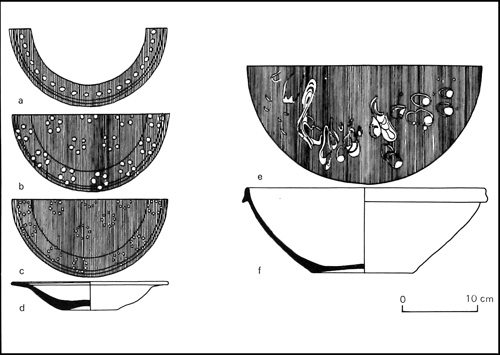
22 Red-fabric coarse earthenware vessels and associated decoration;
a, b and c, "circles of dots"
(Photo by G. Lupien.)
|
2. Marbled-Slip Bowl
The fabric is very hard, dense, slightly sandy and dark red. As a
result of being fired in an oxidizing atmosphere in the kiln, the
unglazed exterior has become pale buff in colour. The inside of the bowl
is covered in a fine purified lead glaze over a marbling of white slip
applied while the vessel was very wet — probably while it was still
on the wheel. The vessel was then lightly joggled so the marbling is
restricted to one part of the vessel only. The colour effect is a white
to yellow pattern on a rich dark red surface (Figs. 22e, f, 23).
Comparative material was found at the Fortress of Louisbourg.
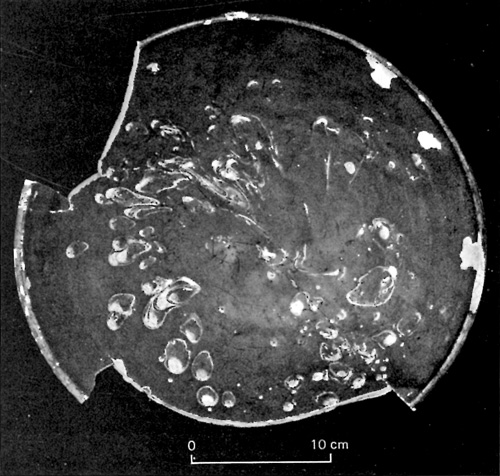
23 Marbled-slip red-fabric coarse earthenware bowl, decoration on
plates; d, plate with "circles of dots" decoration; e,
decoration on marbled-slip bowl, and f, marbled-slip bowl.
(Drawing by author.)
|
3. White-Slipped Red ware Dishes with Applied Green Colour
Decoration
These dishes (Fig. 23c) are in a hard, pale pink fabric,
unglazed areas of which fire to a rich buff or salmon-red colour. The
fabric is slightly vesicular, but is without any visible or distinct
inclusions. The bases were turned while the vessel was leather-hard.
The insides were washed with white slip and subsequently decorated
with a pattern in green colour. The original glaze colour of most of the
vessels has been altered in the fire aboard ship. Two patterns occur:
nine examples of the pattern illustrated in Figures 24b and 25
and three examples of the pattern illustrated in Figure 24a.
There are slight variations in the height between 3.5 cm. and 4.5
cm.; the principal height is 4 cm. The width is constant at 10.5 cm.
Comparative material was recovered at the Fortress of Louisbourg.
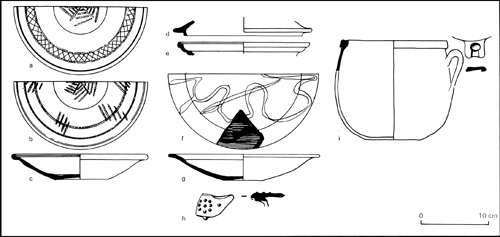
24 Miscellaneous decorated and undecorated coarse earthenware vessels
and associated decoration. a and b, applied green colour
decoration on white slipped redware dishes, and c, white slipped
red-ware dish with applied green colour decoration. Fine brown-glazed
red earthenware objects with black trailed slip decoration; d,
lid; e, plate; g, plate, and h, porringer handle,
f, black trailed slip decoration on fine brown-glazed red
earthenware plate, and i, undecorated coarse earthenware cooking
pot.
(Drawing by author.)
|
4. Fine Brown-Glazed Red Earthenware with Black Trailed Slip
Decoration
The fabric is very hard, very fine, dark red earthenware without
inclusions. The vessels, which include plates (Figs. 24e, g,
27a, c), dishes, porringers, lids (Figs. 24d, 27b)
and a tureen handle (Figs. 24h, 27d), are decorated with
black lines poured randomly over the surface, all under a dark and
lustrous deep-brown glaze (Fig. 24f).
A tureen handle has a press-moulded design of raised studs. As this
material is very fragmentary, parallels have been drawn from material
found at Fort Beauséjour and at the Fortress of Louisbourg.
Fragments of four other plates parallel the plate illustrated in
Figure 24g.
5. Cooking Pot
A small fragment of the rim and handle and eight rim fragments of a
cooking pot were recovered. The illustration (Fig. 24i) is based
on the rim and handle fragment and comparative material from Fort
Beauséjour and the Fortress of Louisbourg.
The vessel is of coarse buff fabric. The short strap handle has a
markedly inturned flange and deep thumbing at the top; it was applied
below the rim. Pale green glaze is present on the inside of the pot.
The nine rim fragments range in diameter from 8 cm. to 10 cm.
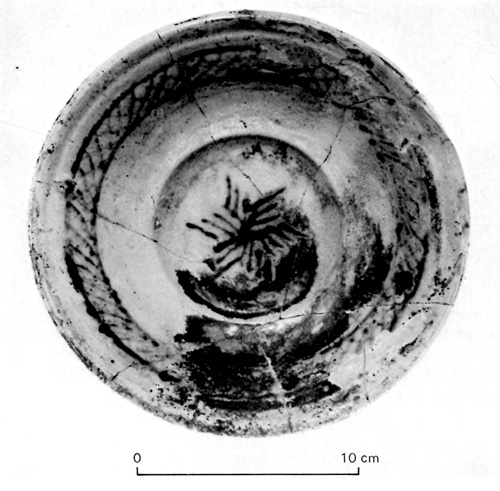
25 White slipped redware dish with applied green colour decoration.
(Photo by G. Lupien.)
|
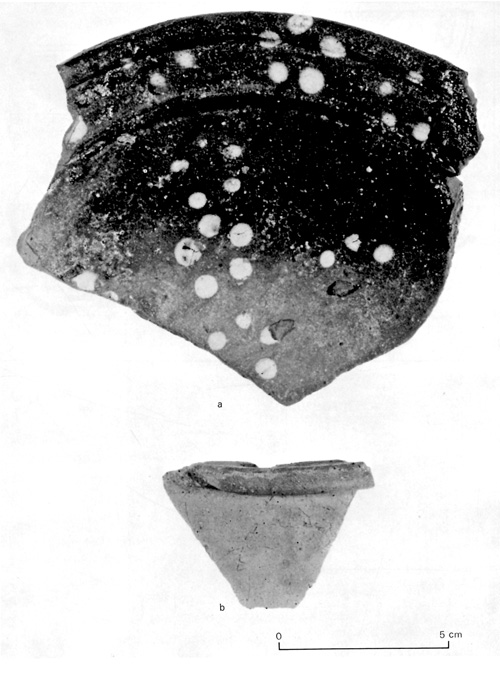
26 Miscellaneous coarse earthenware; a, plate shard with "circles
of dots" decoration, and b, undecorated cooking pot rim sherd.
(Photo by J. Jolin.)
|

27 Fine brown-glazed red earthenware objects with black trailed slip
decoration; a, plate sherd; b, lid shard; c, plate
shard, and d, porringer handle.
(Photo by J. Jolin.)
|
|

